By Eilene Lyon
Too Little Water
August 12, 2018
The Animas River is at an all-time historic low (and they are still drawing irrigation water – sorry, New Mexico!). As of Friday, it was running at 131 c.f.s. The average for this time is about 600 c.f.s.
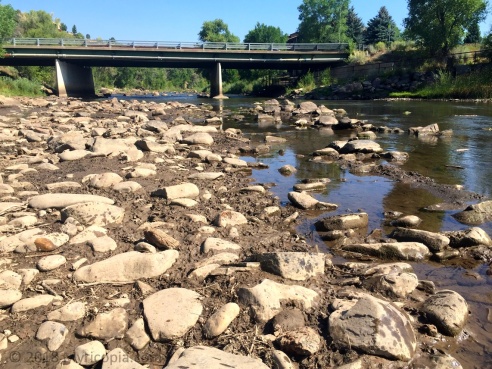
I don’t normally stand in the “river”
As the surface level drops, the water gets warmer, turning the rocks bright green with algae, depriving the aquatic life of oxygen. But what about the fish? Oh no worries – they all died when the ash and debris from the “416 Fire” came washing down a few weeks ago.
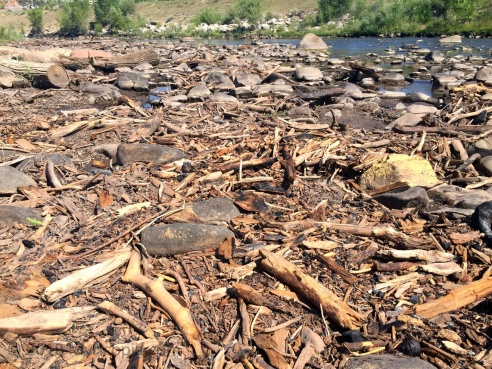
Charred debris in the Animas River
The gold medal trout waters near town will be fine. Colorado Parks and Wildlife stocks all the fish in the river, anyway. The mineral load from the Silverton mining district prevents any fish from reproducing naturally.
Here at home, I’m still watering the gardens (we don’t have any lawn). As the trickle of river flows past, I have to wonder about the aquifer below us. When will we discover the well has gone dry – when I turn on the tap and nothing comes out?
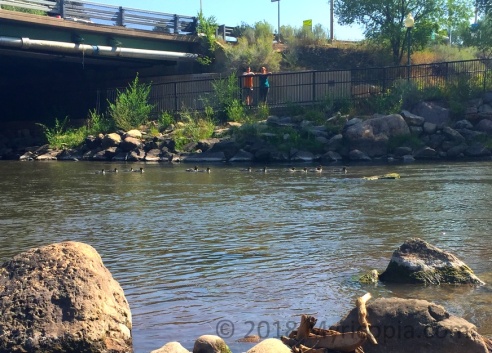
Fortunately there’s still enough water for this flotilla of mergansers.
The Gambel oak acorns are turning brown and being jettisoned. When the wind blows, it sounds like a micro hailstorm or fusillade. It seems a bit early, but maybe they can’t invest any more resources in seed production.
In fact there seems to be a bumper crop of acorns and chokecherries this year. I wonder if the plants thought it was going to be a better year? Or perhaps it’s just the opposite: they sense their impending doom and are going all out to ensure potential offspring in abundance. The seeds will abide in the duff and topsoil until conditions are more favorable. Soon, we hope.
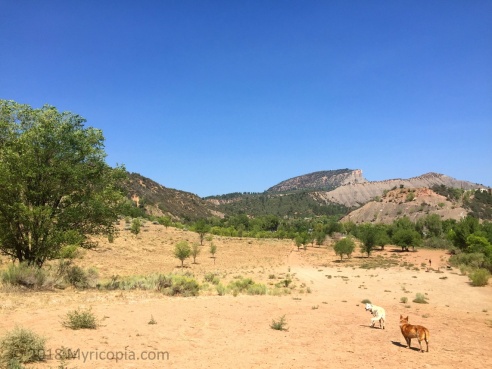
Normally our monsoon season runs from mid-July to mid-September. Here we are in mid-August and they still haven’t appeared. Do you see those monsoonal clouds building up on the horizon? Nope? Me either.

Oh, there they are! Probably bluffing as usual. [For the record, we got 0.03 inches of rain]
Too Much Water
Certainly writing about too little water in a drought is a no-brainer, but sometimes we get too much, too quickly.
June 14, 1932
Friday a cloudburst washed out the flax. Darn it! Flax is a good price and every year something happens to it…Monday Dad was out in the potato field knocking potato bugs off the plants into a pail. He was going to kill them by pouring kerosene over them. When a sudden hailstorm came up, he set the pail down in the barnyard so he could help with the terrified horses. A horse kicked the bucket over. Several thousand of Dad’s little jewels went back to the potato field.
— Ann Marie Low Dust Bowl Diary
Whether the soil is scorched by a blazing sun or a blazing forest, it will refuse to absorb a heavy rainfall. The water rolls down like off a newly waxed car. Where it does soak in on denuded slopes, the resulting mud and rocks will come down instead of water.
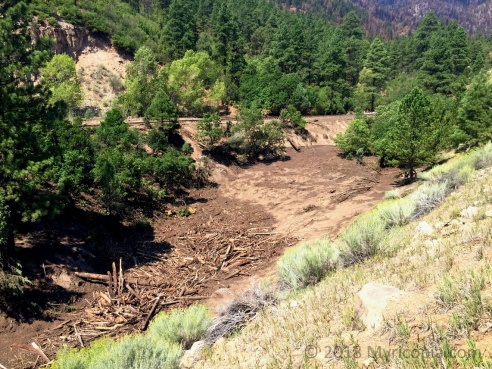
The cause of the 416 Fire is “unknown” only to the Forest Service. Everyone else knows it was started by the train and its coal-burning, ember-spewing locomotives. The mud flow from a recent downpour has made this section of track unusable. Payback’s a you-know-what!

Mud and rocks threatened and damaged many homes below the burn area.
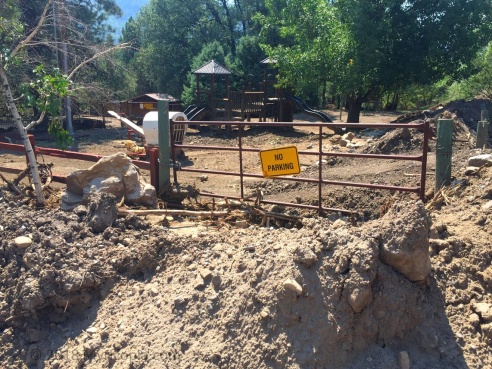
The new owner of the KOA Kampground was dismayed to see the place overrun. She felt somebody should “do something,” though who and what wasn’t clear. No one impacted by the mud slides is covered by insurance for flood damage.
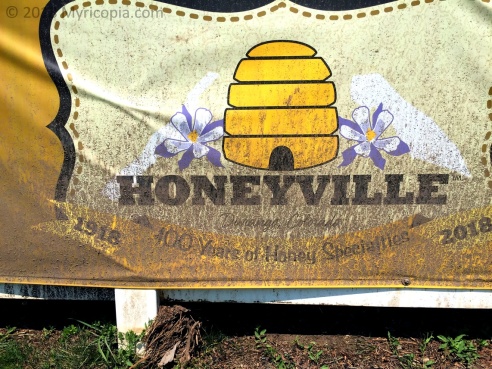
A favorite local business, Honeyville, is right in the bulls-eye zone for mud and debris from the burn area.
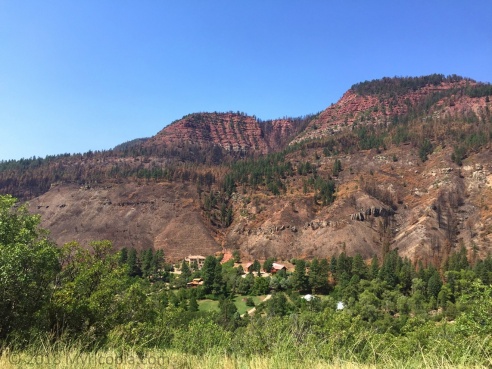
Future mudslides waiting to happen. Don’t you bet those homeowners love fire fighters?!

Our local rock-stacking artist usually works in the river. Perhaps it was too muddy? Or maybe he decided he was tired of round rocks.
Feature image: Looking downstream from the Durango Dog Park. The section of river below this point is heavily modified for a white-water park. No kayaks and rafts on the river today!
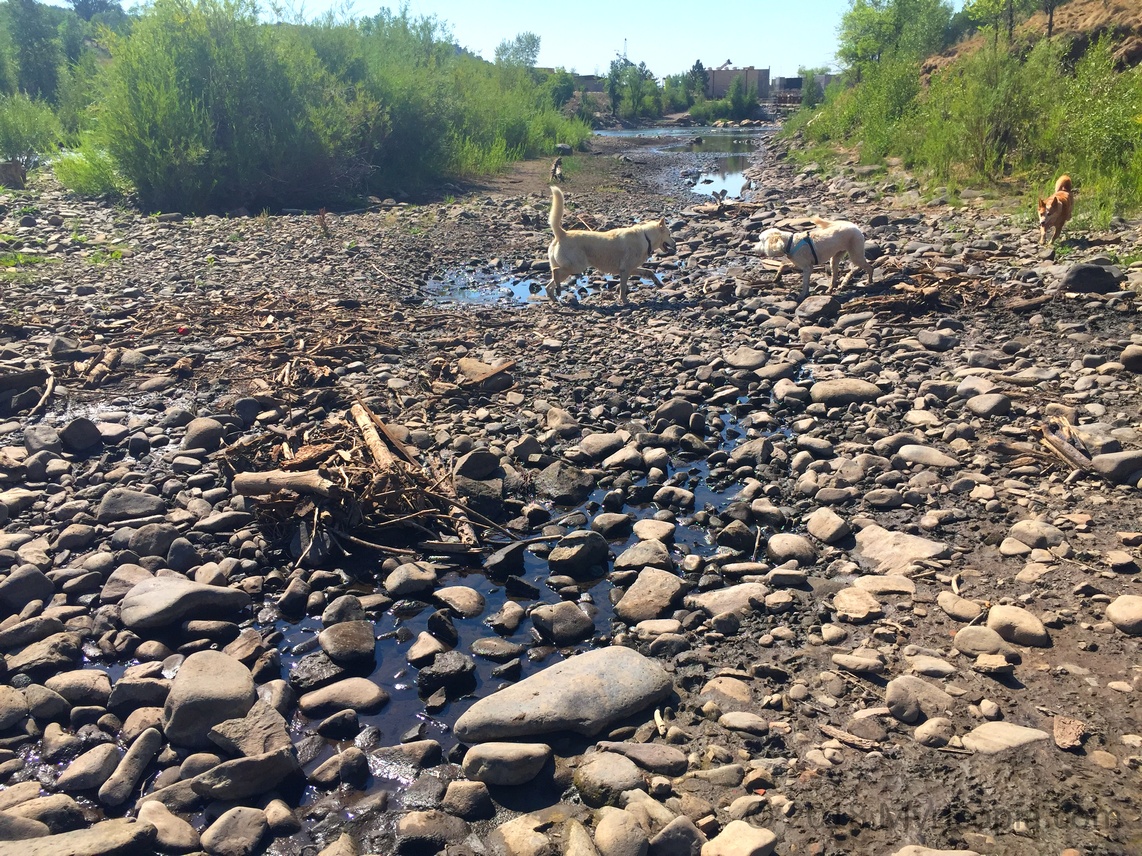
Wow. Super interesting and the rock artistry i almost missed if not for your description.
LikeLiked by 1 person
The sun was too bright to get any good contrast at noon, unfortunately. I’ll have to try again at a different time of day.
LikeLiked by 1 person
These scenes really make me feel respectful for the forces of nature (and Karma)
LikeLiked by 1 person
Mother Nature strikes back!
LikeLiked by 1 person
B.C. is experiencing a little of this. It has 595 active fires right now. Ashcroft area had major fires last year and just had a mudslide. Continued droughts in the years to come will be a problem, unless we learn how to manage our forests in anticipation of the changing climate.
LikeLiked by 1 person
I think we have a good idea how to manage the forests, but politics and misunderstanding get in the way of doing the right things.
LikeLiked by 1 person
True!
LikeLiked by 1 person
A couple of years ago, while driving around “checking crops” my father-in-law pointed out a large concrete structure sitting all by itself in the middle of a flatter than flat soy bean field.
“What do you think that is?” he asked.
“I dunno,” I told him.
“It’s a dam and when I was a kid, there was fifteen feet of water pouring over it.”
“So where did all the soil go?” I asked.
“Some went to Iowa, some to Wisconsin, some to Illinois and Michigan…and some is still probably airborne.”
That much soil blew away.
LikeLiked by 1 person
It’s almost unimaginable, huh? The Soil Conservation Service has done a lot to prevent it from happening again, but Mother Nature is probably just chuckling at our hubris.
LikeLiked by 1 person
This erosion is recent and ongoing.. The land to our immediate west was once a vast (17,000 acre) wetland, as was much of south central Minnesota. It was drained in the 20’s and converted over to vegetable cropland. When the wind blows from the west, you don’t want to be hanging out your wash because it will turn black. The area has lost a good ten feet of black topsoil. Topsoil around here can go as deep as 26 feet.
There has been some effort to convert it back to wetland…. some.
LikeLiked by 1 person
Really?! Wow. We never learn, do we? All the work the Army Corp of Engineers did to straighten rivers and control flooding just created more problems, too. We think we’re so good at managing nature for our benefit. What a joke.
LikeLiked by 1 person
Horrifying to read. On a minor matter, I was interested to read a BBC article about rock-stacking recently. Apparently some conservationists think it harms the environment (disturbs communities living under rocks I suppose). I thought that was a bit of an overreaction.
LikeLiked by 1 person
There’s a move by the Park Service to discourage building of small cairns along trails, because it detracts from the fiction that these places are unmarred by human activity. Okay, fine. And it’s true that pulling rocks up can sometimes disturb insects and such. But, yeah, I’d agree to the overreaction characterization. We impact the environment and so does every other living thing, just not to the extent we do.
LikeLiked by 1 person
I can relate! We are definitely in the ‘too little’ water cycle this year as well…and surrounded by wild fires! Good luck keeping your garden hydrated!
LikeLiked by 1 person
So far, so good. Wishing some rain your way, too!
LikeLike